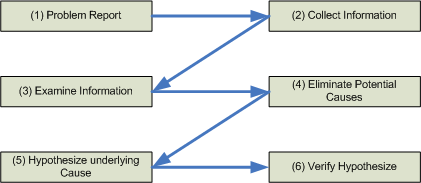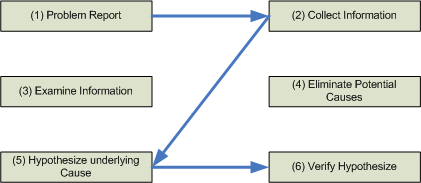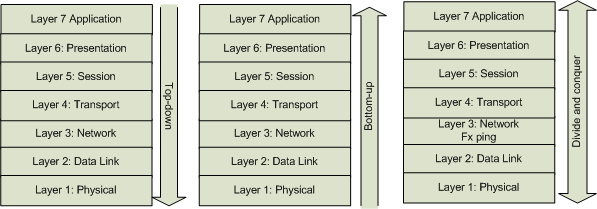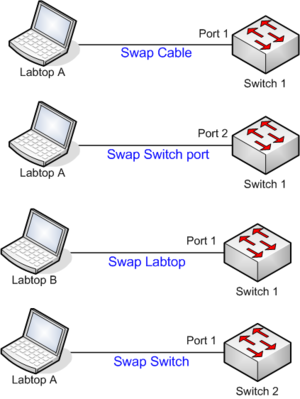CCNP TSHOOT Learning Guide/Chapter 2
From Teknologisk videncenter
Trobleshooting Processes for Complex Enterprise Networks
Introduction to Troubleshooting Processes
Troubleshooting Methods
Defining Troubleshooting
- Step 1: Problem Report
- Step 2: Problem Diagnosis
- Step 3: Problem resolution
Diagnosing a Problem
| Step | Description |
|---|---|
| Collect Information | A problem report often lacks sufficient information. Collect additional information from. fx. Network Management tolls or interviewing the user. |
| Examine Collected Information | Examine collected information. Fx. comparing to baseline information. |
| Eliminate Potential causes | Based on knowledge of network and collected information - start to eliminate causes. |
| Hypothesize Underlying Cause | After eliminating causes hypothesize the most likely cause of the problem. |
| Verify Hypothesis | Test if the hypothesize resolve the problem |
The Value of a Structured Troubleshooting Approach
Popular Troubleshooting Methods
Structured Troubleshooting Procedure
By combining the previously mentioned Three-step troubleshooting procedure and the subprocesses of Problem Diagnosis steps you get
- Problem Report
- Collect Information
- Examine Collected Information
- Eliminate Potential Causes
- Hypothesize Underlying Cause
- Verify Hypothesize
- Problem resolution
Problem Report
- Often lacks information
- Are you authorized to resolve the problem or need to forward it.
- Interview the user who reported the problem.
Collect Information
- Collect information from routers and switches... (show debug commands, log, NMS etc)
Examine Collected information
- Identify indicators pointing to the underlying cause of the problem
- Find evidence that can be used to eliminate potential causes
Fin a balance between
- What is occurring on the network?
- What should be occurring on the network?
Eliminate Potential Causes
- Is OSPF running etc.
Hypothesize Underlying Cause
- If problem can't be resolved (Lack of authority, devices) a temporary fix could resolve the problem here and now.
Verify Hypothesis
- Implementing the fix. (Make a plan)
Problem resolution
- Document the resolved problem.
Including Troubleshooting in Routine Network Maintenance
- Keep documentation up to date and reliable
Maintaining Network Documentation
- Require documentation - Make documentation a component in the troubleshooting flow. (get used to documenting)
- Schedule documentation checks - Routinely verify documentation.
- Automate documentation - Any configuration change on a device should be reflected in the documentation. (Compare)
Establish a baseline
R1#<input>show processes cpu sorted 5min</input>
CPU utilization for five seconds: 5%/0%; one minute: 5%; five minutes: 5%
PID Runtime(ms) Invoked uSecs 5Sec 1Min 5Min TTY Process
112 3719202 1028129 3617 0.15% 0.13% 0.15% 0 HRPC qos request
4 2111767 304796 6928 0.00% 0.09% 0.06% 0 Check heaps
139 232 304 763 0.15% 0.11% 0.05% 2 Virtual Exec
142 554927 2283402 243 0.15% 0.10% 0.05% 0 IP Input
34 57731 47158926 1 0.00% 0.02% 0.00% 0 RedEarth Tx Mana
7 637306 3220477 197 0.15% 0.03% 0.00% 0 ARP Input
6 0 2 0 0.00% 0.00% 0.00% 0 Timers
<notice> Output omitted... </notice>Communicating throughout the Troubleshooting Process
| Step | Description |
|---|---|
| Problem Report | When a user report a problem. Communicate with the user to clarify the problem. |
| Collect Information | Collect information from for example a Service Provider. require communication. |
| Examine Collected Information | Communicate with other IT-staff |
| Eliminate Potential causes | Perhaps the troubleshooter communicate with a consultant. |
| Hypothesize Underlying Cause | The communication with other IT-staff helps to clarify the underlying problem. |
| Verify Hypothesis | Before making online network changes causing outlets. Notify users about the interruption. |
| Problem Resolution | The user reporting the problem should be informed and the user confirm that the problem is resolved. |
Change Management
The process of Change Management includes using policies that dictate rules regarding how and when a change can be made and how that change is documented.




